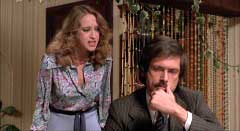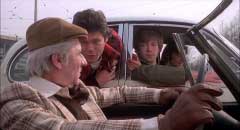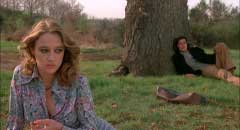 YOUNG,
VIOLENT, DANGEROUS (1976)
YOUNG,
VIOLENT, DANGEROUS (1976)Director: Romolo Guerrieri
Raro Video USA
 YOUNG,
VIOLENT, DANGEROUS (1976)
YOUNG,
VIOLENT, DANGEROUS (1976)Tomas Milian battles youth-gone-bad in Romolo Guerrieri's YOUNG, VIOLENT, DANGEROUS, a 1976 Italian crime thriller scripted by Fernando Di Leo (SLAUGHTER HOTEL) out on DVD from Raro Video USA.

Young Lea (Eleonora Giorgi, INFERNO) warns a Milanese police commissioner (Tomas Milian, ALMOST HUMAN) that her boyfriend Luigi Morandi (Max Delys, ANDY WARHOL’S L’AMOUR) – aka “Luis” – and his friends Mario Farra (Stefano Patrizi, MURDER OBSESSION) – aka “Blondie” – and Giovanni Etruschi (Benjamin Lev, EYE IN THE LABYRINTH – aka “Joe” – are planning to stick up a gas station that very morning at 9 A.M. She insists that they are just mixed-up kids who don’t know what they are really risking, and inquiries with their apathetic parents seem to bear this out; so they are both surprised when the robbery turns into a violent shoot-out that leaves the gas station owner and three stakeout cops dead. Luis, Blondie and Joe manage to get past road blocks by switching getaway cars and even catching the bus; however, they are not really on the run. After robbing a bank – and tossing the lute into the scrambling crowd of a farmer’s market – they meet up with “studly” gun-runner Lucio (Diego Abatantuolo, I’M NOT SCARED) and three other “young, violent, dangerous” men to rob a major supermarket before so casually double-crossing their four partners in crime. The three head over to Lea’s as a potential hideout, but Blondie quickly figures out that it was she who sold them out, and she becomes a not-too-imperiled hostage as they take to the road again. Meanwhile, the commissioner and the boys’ parents are left to ponder – while waiting for the inevitable next bloodbath – why three well-off young men have suddenly turned into vicious killers.
 That
question would seem to be at the very heart of YOUNG, VIOLENT, DANGEROUS (aka
LIBERI, ARMATI, PERICOLOSI), but such sociological questions are abandoned mid-way
through after Milian dresses down the parents who see loving their children
and providing for them as being mutually exclusive; fortunately, the film does
stop short of suggesting that lack of attention explains their crimes, but Luis’
father does ask if the commissioner is justifying their actions by explaining
where they [the parents] went wrong. Although Raro’s cover and the poster
art would have you believe that this is another Tomas Milian poliziotteschi
film, Milian is actually given a prominent credit after the title while Patrizi,
Lev and Delys are all given above-the-title billing. The film’s focus
is indeed on the young, violent and dangerous youths; and it would have worked
had the scripting and acting of the three young leads been on the same level
as Milian, who simply follows leads and looks pensive. The primary trio of characters
and actors are almost completely one dimensional: Luis is conflicted (but only
in as much as to allow him to stand around impotent as violence explodes around
him), Joe is fixed in loose-cannon mode, and Blondie is cold and calculating
but given to bursts of violence when his manhood is called into question. Late
in the film, Lea calls Luis and Blondie on the homoerotic tension between the
two of them, which she describes as a mental game of wills; however, the mental
game actually seems to be between Blondie and Lea over Luis, and the script
and film seem to realize this too late to make effective use of it (although
the looks traded between Patrizi and Giorgi are more effective and subtle than
those between Patrizi and Delys). There is an interesting scene, however, when
Joe and Blondie come across a German father and son camping trip that Joe assumes
to be a gay couple (using a more derogatory term), and Blondie seems to look
on them as a curiosity. The climax was of course going to hinge on Luis “finding
some balls” – as both Lea and Blondie had urged him to do (with
different phrasing) – but the people in the film are the only ones who
won’t be seeing his final act coming a mile away. In the meantime, however,
we are treated to some crowd-pleasing violence (the supermarket scene has the
automated sales announcements continuing on the soundtrack during the shooting
and looting, and some deaths are abrupt enough to have viewers shaking their
heads at how much deeper these characters are digging themselves), and Giorgi
gets stripped to provide a distraction to a police helicopter.
That
question would seem to be at the very heart of YOUNG, VIOLENT, DANGEROUS (aka
LIBERI, ARMATI, PERICOLOSI), but such sociological questions are abandoned mid-way
through after Milian dresses down the parents who see loving their children
and providing for them as being mutually exclusive; fortunately, the film does
stop short of suggesting that lack of attention explains their crimes, but Luis’
father does ask if the commissioner is justifying their actions by explaining
where they [the parents] went wrong. Although Raro’s cover and the poster
art would have you believe that this is another Tomas Milian poliziotteschi
film, Milian is actually given a prominent credit after the title while Patrizi,
Lev and Delys are all given above-the-title billing. The film’s focus
is indeed on the young, violent and dangerous youths; and it would have worked
had the scripting and acting of the three young leads been on the same level
as Milian, who simply follows leads and looks pensive. The primary trio of characters
and actors are almost completely one dimensional: Luis is conflicted (but only
in as much as to allow him to stand around impotent as violence explodes around
him), Joe is fixed in loose-cannon mode, and Blondie is cold and calculating
but given to bursts of violence when his manhood is called into question. Late
in the film, Lea calls Luis and Blondie on the homoerotic tension between the
two of them, which she describes as a mental game of wills; however, the mental
game actually seems to be between Blondie and Lea over Luis, and the script
and film seem to realize this too late to make effective use of it (although
the looks traded between Patrizi and Giorgi are more effective and subtle than
those between Patrizi and Delys). There is an interesting scene, however, when
Joe and Blondie come across a German father and son camping trip that Joe assumes
to be a gay couple (using a more derogatory term), and Blondie seems to look
on them as a curiosity. The climax was of course going to hinge on Luis “finding
some balls” – as both Lea and Blondie had urged him to do (with
different phrasing) – but the people in the film are the only ones who
won’t be seeing his final act coming a mile away. In the meantime, however,
we are treated to some crowd-pleasing violence (the supermarket scene has the
automated sales announcements continuing on the soundtrack during the shooting
and looting, and some deaths are abrupt enough to have viewers shaking their
heads at how much deeper these characters are digging themselves), and Giorgi
gets stripped to provide a distraction to a police helicopter.

After the four have made it past a road block without incident, Joe calls out “La polizia è al servizio del cittadino” – the title of director Romolo Guerrieri’s previous crime film, and “Milano violenta, la polizia non relenta!” – the title of a Mario Ciaino film made the same year – and one of the police officers gives the commissioner one of the newspaper headlines about the case as “La polizia brancola nel buio”, which is the title of an Italian/Turkish giallo made the previous year. The film was one of two screenplays by Fernando Di Leo following his great “Milieu” trilogy that were not helmed by the director (the other being Ruggero Deodato’s LIVE LIKE A COP, DIE LIKE A MAN). As with NAKED VIOLENCE, CALIBER 9 and THE ITALIAN CONNECTION, Di Leo sought inspiration in another novel by Giorgio Scerbanenco; however – either through the source novel, Di Leo’s initial scripting, or Guerrieri’s changes – it is the least interesting of the four. Co-credited on the screenplay is Nico Ducci, but Ducci may have come in with Guerrieri to make changes since he had previously scripted Guerrieri’s CITY UNDER SIEGE and would later script the director’s COVERT ACTION (Ducci also scripted the late era spaghetti westerns CALIFORNIA and KEOMA. Di Leo’s usual production designer Francesco Cuppini, but his pop-art sensibilities only show up in Lea’s apartment while the rest of the environs are either bland and bureaucratic or rustic. Franco Di Girolamo (ZOMBI 3) is credited with make-up, and there are some gory aftermaths to shootings and a vicious dog attack.
 The
film was also produced by Armando Novelli, who produced ten of Di Leo’s
directorial efforts, as well as the Di Leo-scripted sex comedy SESSO IN TESTA
(on US DVD through MYA Communication as ITALIAN SEX, one of their typically
nonsensical retitlings). Co-producer Ermano Curti produced Di Leo’s NICK
THE STING the same year, as well as Paolo Cavara’s PLOT OF FEAR (forthcoming
on disc from Raro). The score credited to Gianfranco Plenizio – a composer
better known as a conductor for Guido and Maurizio De Angelis and later Pino
Donaggio (following his long-term collaboration with Natale Massara) –
and Enrico Pieranunzi has little presence in the film other than the uncredited
easy listening title vocal (“Look around you child, see the world gone
wild!”) and harmonica instrumental variations on it. Italy’s Beat
Records released the soundtrack on CD in 2008 (even they don’t know who
sang the song, since the liner notes only make the supposition that it was Ann
Collin). Familiar Italian genre faces Venantino Venantini (EMANUELLE AND THE
WHITE SLAVE TRADE) and Tom Felleghy (THE CAT O’NINE TAILS) show up as,
respectively, Luis’ exporter father and Blondie’s professor father.
The
film was also produced by Armando Novelli, who produced ten of Di Leo’s
directorial efforts, as well as the Di Leo-scripted sex comedy SESSO IN TESTA
(on US DVD through MYA Communication as ITALIAN SEX, one of their typically
nonsensical retitlings). Co-producer Ermano Curti produced Di Leo’s NICK
THE STING the same year, as well as Paolo Cavara’s PLOT OF FEAR (forthcoming
on disc from Raro). The score credited to Gianfranco Plenizio – a composer
better known as a conductor for Guido and Maurizio De Angelis and later Pino
Donaggio (following his long-term collaboration with Natale Massara) –
and Enrico Pieranunzi has little presence in the film other than the uncredited
easy listening title vocal (“Look around you child, see the world gone
wild!”) and harmonica instrumental variations on it. Italy’s Beat
Records released the soundtrack on CD in 2008 (even they don’t know who
sang the song, since the liner notes only make the supposition that it was Ann
Collin). Familiar Italian genre faces Venantino Venantini (EMANUELLE AND THE
WHITE SLAVE TRADE) and Tom Felleghy (THE CAT O’NINE TAILS) show up as,
respectively, Luis’ exporter father and Blondie’s professor father.
 While
Raro Video USA gave the HD-mastered overhaul to their reissues of Raro Italy’s
non-anamorphic transfers of LIVE LIKE A COP, DIE LIKE A MAN and MURDER OBSESSION,
they have brought YOUNG, VIOLENT, DANGEROUS to NTSC DVD in a single-layer, progressive,
non-anamorphic 1.85:1 transfer. Colors are not particularly vibrant, but that
may be down to the décor and costume choices, but the print source is
not free from damage. Little bits of debris pop up once in a while, as well
as some green stains, and a vertical tear that lasts several frames (the clips
in the documentary look far worse, probably VHS). The film is viewable with
either English or Italian Dolby Digital 2.0 mono audio. The Italian track is
the way to go with this film; the English dub is fine as far as 1970s dub-jobs
go, but the Italian track sounds cleaner and louder (also Lev is even more irritating
dubbed into English). On the English track, Luigi Morandi becomes Louis Mayer,
Mario Farra becomes Paul Farley (although I’m pretty sure his father is
still called “Professor Farra” in the dub), and Giovanni Etruschi
becomes Joseph Edward. The optional subtitles also reveal that the Italian dialogue
is sometimes cruder than the English dub.
While
Raro Video USA gave the HD-mastered overhaul to their reissues of Raro Italy’s
non-anamorphic transfers of LIVE LIKE A COP, DIE LIKE A MAN and MURDER OBSESSION,
they have brought YOUNG, VIOLENT, DANGEROUS to NTSC DVD in a single-layer, progressive,
non-anamorphic 1.85:1 transfer. Colors are not particularly vibrant, but that
may be down to the décor and costume choices, but the print source is
not free from damage. Little bits of debris pop up once in a while, as well
as some green stains, and a vertical tear that lasts several frames (the clips
in the documentary look far worse, probably VHS). The film is viewable with
either English or Italian Dolby Digital 2.0 mono audio. The Italian track is
the way to go with this film; the English dub is fine as far as 1970s dub-jobs
go, but the Italian track sounds cleaner and louder (also Lev is even more irritating
dubbed into English). On the English track, Luigi Morandi becomes Louis Mayer,
Mario Farra becomes Paul Farley (although I’m pretty sure his father is
still called “Professor Farra” in the dub), and Giovanni Etruschi
becomes Joseph Edward. The optional subtitles also reveal that the Italian dialogue
is sometimes cruder than the English dub.
 The
only substantial extra is the featurette “Ragazzi Fuori” (16:51)
featuring Romolo Guerrieri – whose real surname is Girolami (he is the
brother of Marino Girolami [ZOMBI HOLOCAUST] and uncle of director Enzo Casterelli
[THE LAST SHARK]) – who speaks highly of Di Leo, Scerbanenco, Milian (who
he had to persuade to return to “this type of film”) and Giorgi.
He also reveals that Lev was absent for a lot of the film, having been stopped
by the police and held under suspicion of pushing drugs, and that Guerrieri
had to use a stand-in for him for a lot of the shoot (and it’s extremely
well hidden). The cover and extras menu promise PDF liner notes (seemingly a
cost-cutting move as previous discs, some of which had glossy inserts with brief
liner notes while others had impressive Criterion-esque booklets). Although
the extras menu instructs the viewer how to access the PDF file using a DVD-ROM
drive, the file is absent from the disc folder. The disc does however feature
one of Raro’s best main menu montages set to the film’s theme song.
(Eric
Cotenas)
The
only substantial extra is the featurette “Ragazzi Fuori” (16:51)
featuring Romolo Guerrieri – whose real surname is Girolami (he is the
brother of Marino Girolami [ZOMBI HOLOCAUST] and uncle of director Enzo Casterelli
[THE LAST SHARK]) – who speaks highly of Di Leo, Scerbanenco, Milian (who
he had to persuade to return to “this type of film”) and Giorgi.
He also reveals that Lev was absent for a lot of the film, having been stopped
by the police and held under suspicion of pushing drugs, and that Guerrieri
had to use a stand-in for him for a lot of the shoot (and it’s extremely
well hidden). The cover and extras menu promise PDF liner notes (seemingly a
cost-cutting move as previous discs, some of which had glossy inserts with brief
liner notes while others had impressive Criterion-esque booklets). Although
the extras menu instructs the viewer how to access the PDF file using a DVD-ROM
drive, the file is absent from the disc folder. The disc does however feature
one of Raro’s best main menu montages set to the film’s theme song.
(Eric
Cotenas)